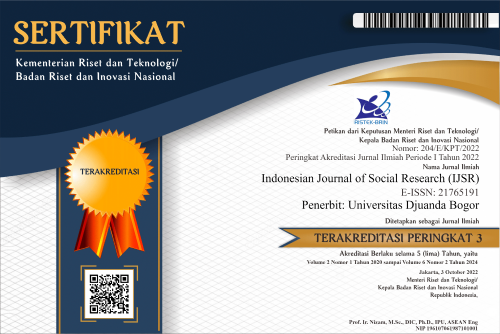Urban School Climate (USC): The Study of Teacher Perceptions of Safe and Comfortable School Atmosphere in Elementary School
Abstract
Building child-friendly schools is teachers' main task so students can learn safely and comfortably. However, there are still teachers who still need to be fully aware of this. This research aims to explore elementary school teachers' perceptions of a safe and comfortable environment as an illustration of the Urban School Climate (USC). This research method is a case study with a qualitative approach. Interviews with elementary school teachers in Bogor carried out data collection. Conversations are carried out directly (face-to-face) and are recorded to ensure that the interview results match the respondent's information. Our research involved 45 teachers with permanent teacher (PT) status in 17 elementary schools in Bogor, Indonesia. The recruitment of teachers who would share their valuable insights was carried out using a purposive sampling technique. Data analysis was carried out using the Miles and Huberman model, including data reduction, display, and verification. The data analysis was assisted with Nvivo 12 software. The research results showed a safe and comfortable environment as an illustration of USC, including 1) a pleasant school atmosphere for students and teachers, adequate facilities and a mutually supportive atmosphere, 2) a safe environment, 3) a comfortable environment, and 4) school policies which lead to restrictions for parents when picking up their children at school, regulations regarding discipline and various binding regulations. The impact of the results of this research is that schools can build a school climate by referring to the characteristics of USC, which are described as a safe and comfortable school atmosphere and environment.
References
Aminpour, F. (2023). Child-friendly environments in vertical schools: A qualitative study from the child’s perspective. Building and Environment, 242, 110503.
Back, L. T., Polk, E., Keys, C. B., & McMahon, S. D. (2016). Classroom management, school staff relations, school climate, and academic achievement: Testing a model with urban high schools. Learning Environments Research, 19, 397–410.
Barliana, M. S., Purnamaningsih, M., Ramadhan, T., & Susanti, I. (2023). Friendly school design of early childhood based on traditional Sundanese architecture typology. Journal of Asian Architecture and Building Engineering, 22(4), 1995–2005.
Berkowitz, R., Astor, R. A., Pineda, D., DePedro, K. T., Weiss, E. L., & Benbenishty, R. (2021). Parental involvement and perceptions of school climate in California. Urban Education, 56(3), 393–423.
Blitz, L. V., Yull, D., & Clauhs, M. (2020). Bringing sanctuary to school: Assessing school climate as a foundation for culturally responsive trauma-informed approaches for urban schools. Urban Education, 55(1), 95–124.
Cuellar, M. J., Coyle, S., & Weinreb, K. S. (2021). Dealing with the day‐to‐day: Harnessing school climate to address the effects of student victimization on academic performance. Psychology in the Schools, 58(9), 1799–1815.
Cui, K., & To, S. (2021). School climate, bystanders’ responses, and bullying perpetration in the context of rural-to-urban migration in China. Deviant Behavior, 42(11), 1416–1435.
Daryanto, H. T. (2015). Pengelolaan budaya dan iklim sekolah. Yogyakarta: Gava Media.
Erdem, C., & Kaya, M. (2023). The relationship between school and classroom climate, and academic achievement: A meta-analysis. School Psychology International, 01430343231202923.
Fauziah, R. S. P., Kartakusumah, B., Suherman, I., Roestamy, M., Martin, A. Y., & Monaya, N. (2023). How to Improve Healthy Environment in Urban School Climate (USC) by Communication Language Strategies? Arabic Based Communication Language and Statistic Description Analysis. International Journal of Language Education, 7(4). https://doi.org/10.26858/ijole.v7i4.59495
Gunadi, G., & Suherman, I. (2021). Analisis Tingkat Keramahan Lingkungan Sekolah Pada Sekolah Menengah Atas. Tadbir Muwahhid, 5(1), 83–90.
Huang, Y.-H., Lee, J., McFadden, A. C., Murphy, L. A., Robertson, M. M., Cheung, J. H., & Zohar, D. (2016). Beyond safety outcomes: An investigation of the impact of safety climate on job satisfaction, employee engagement and turnover using social exchange theory as the theoretical framework. Applied Ergonomics, 55, 248–257.
Manla, V. H. (2021). School climate: Its impact on teachers’ commitment and school performance. Journal of World Englishes and Educational Practices, 3(2), 21–35.
Miles, M. B., & Huberman, A. M. (1994). Qualitative data analysis: An expanded sourcebook. sage.
Rutherford, L. E., Hier, B. O., McCurdy, B. L., Mautone, J. A., & Eiraldi, R. (2023). Aspects of School-Wide Positive Behavioral Interventions and Supports that Predict School Climate in Urban Settings. Contemporary School Psychology, 27(3), 534–544.
Ryberg, R., Her, S., Temkin, D., Madill, R., Kelley, C., Thompson, J., & Gabriel, A. (2020). Measuring school climate: Validating the education department school climate survey in a sample of urban middle and high school students. AERA Open, 6(3), 2332858420948024.
Saputra, W. N. E., Supriyanto, A., Astuti, B., Ayriza, Y., & Adiputra, S. (2020). The effect of student perception of negative school climate on poor academic performance of students in Indonesia. International Journal of Learning, Teaching and Educational Research, 19(2), 279–291.
Steele, J. L., Steiner, E. D., & Hamilton, L. S. (2021). Priming the leadership pipeline: School performance and climate under an urban school leadership residency program. Educational Administration Quarterly, 57(2), 221–256.
Sugiono, S. (2016). Metode penelitian kuantitatif, kualitatif, dan r & d. Bandung: Alfabeta.
Suharti, L., Sugiarto, A., & Sasongko, G. (2023). Why Does Anti-Bullying Child-Friendly School Program Matter? A Study of Junior High Schools in Indonesia. Journal of Educational and Social Research, 13.
Supeni, S., & Harini, S. (2021). Internalizing character education through Javanese traditional dance to realize child-friendly school. Jurnal Civics: Media Kajian Kewarganegaraan, 18(1), 61–69.
Tubbs, J. E., & Garner, M. (2008). The impact of school climate on school outcomes. Journal of College Teaching and Learning, 5(9), 17.
Varela, J. J., Sánchez, P. A., De Tezanos-Pinto, P., Chuecas, J., & Benavente, M. (2021). School climate, bullying and mental health among Chilean adolescents. Child Indicators Research, 14(6), 2249–2264.
Copyright (c) 2024 Indonesian Journal of Social Research (IJSR)

This work is licensed under a Creative Commons Attribution-ShareAlike 4.0 International License.
The Authors submitting a manuscript do so on the understanding that if accepted for publication, copyright publishing of the article shall be assigned/transferred to Indonesian Journal of Social Research (IJSR) Universitas Djuanda as Publisher of the journal. Upon acceptance of an article, authors will be asked to complete a 'Copyright Transfer Agreement'. An e-mail will be sent to the corresponding author confirming receipt of the manuscript together with a 'Copyright Transfer Agreement' form by online version of this agreement.
Indonesian Journal of Social Research (IJSR) Universitas Djuanda, the Editors and the Editorial Board make every effort to ensure that no wrong or misleading data, opinions or statements be published in the journal. In any way, the contents of the articles and advertisements published in the Indonesian Journal of Social Research (IJSR) Universitas Djuanda are sole and exclusive responsibility of their respective authors and advertisers.
Remember, even though we ask for a transfer of copyright, our journal authors retain (or are granted back) significant scholarly rights as mention before.
The Copyright Transfer Agreement (CTA) Form can be downloaded here: Copyright Transfer Agreement-IJSR 2020
The copyright form should be signed electronically and send to the Editorial Office e-mail below:
Dr. Rasmitadila, M.Pd (Editor-in-Chief)
Universitas Djuanda
Jl. Tol Jagorawi No.1, Ciawi, Kec. Ciawi, Bogor, Jawa Barat 16720
Website: http://journal.unida.ac.id/index.php/IJSR/index
Email: ijsr@unida.ac.id





4.png)



